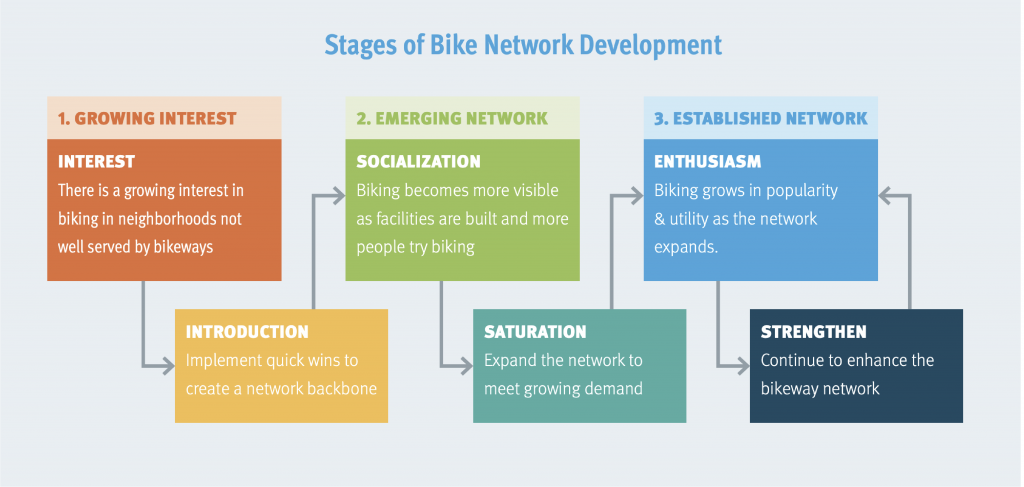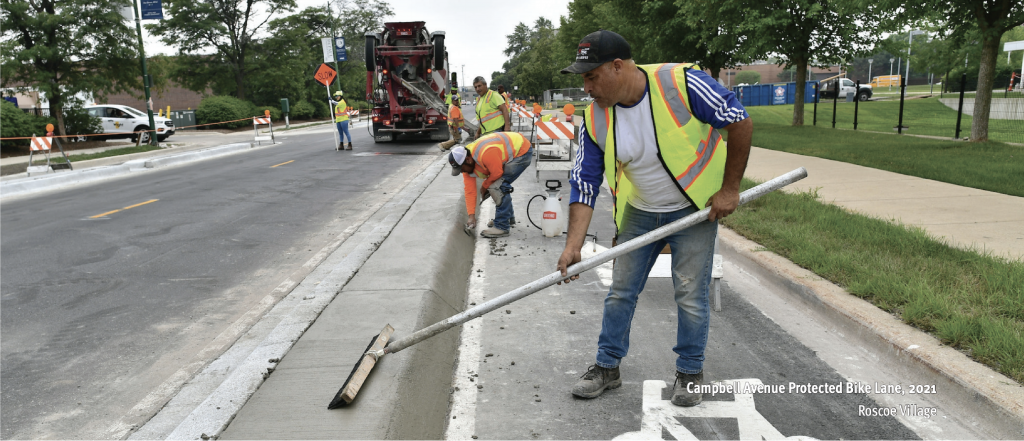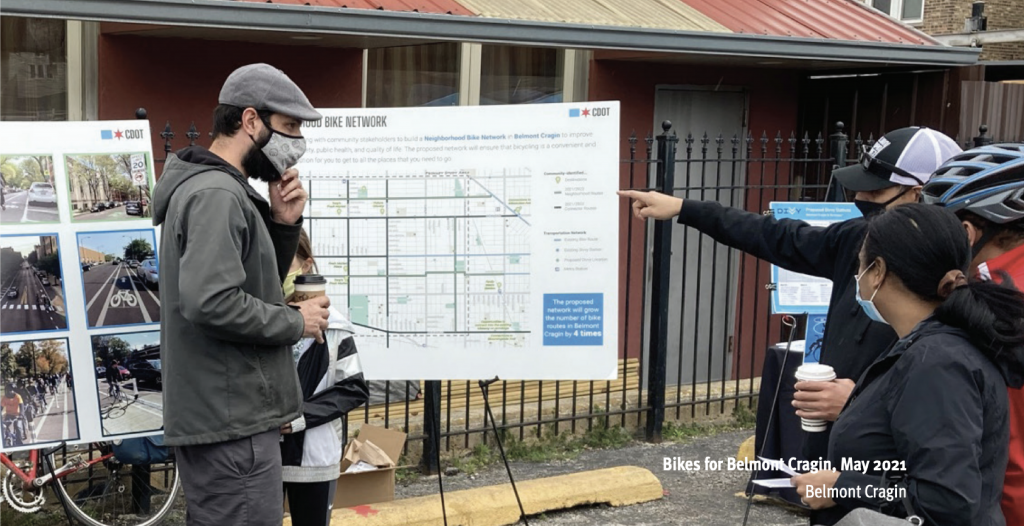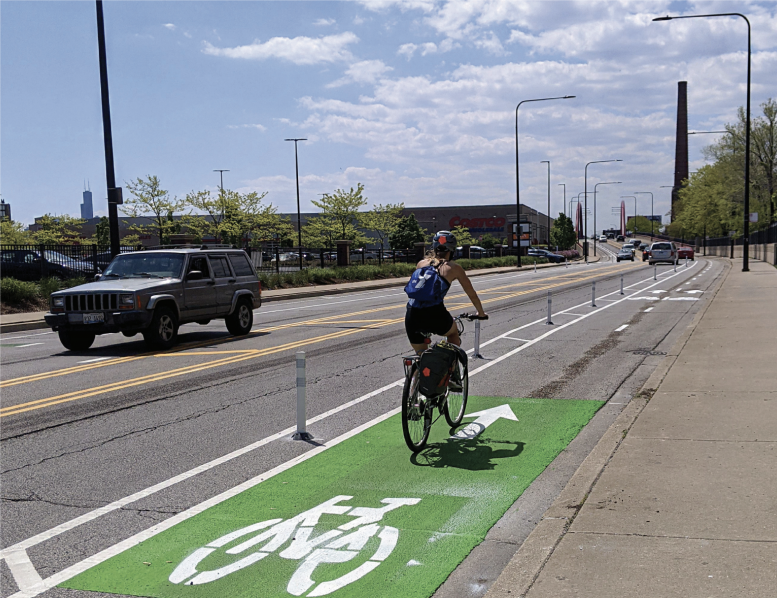The Chicago Department of Transportation (CDOT) confirms plans to finish building nearly 100 miles of new and improved bike lanes over the next year throughout the City of Chicago. In a collaboration with the Chicago Community Cycling Network, the city will continue to work with locals to identify gaps in the current bike network system as the number of bikers increase every year.

Stages of bike network development by CDOT
As 2020 saw a global pandemic, the need to move around and do so safely in the open air led to a substantial rise in demand for bikes, with United States’ bike sales reaching $1 billion by April, an increase of 75 percent from the year before. Chicago has not been immune to this growth, and even with major streets closed for leisure by mid-2020 the city had already surpassed the amount of bicycle related fatalities than the previous years. All of this culminated in a demand from local communities for safe and new bike lanes to serve all reaches of the city including those that are currently unconnected.

New lane installation by CDOT
In Chicago, 51 percent of car rides are under three-miles, 22 percent being under one-mile, most of them could easily be replaced by a short bike ride. Because of that, the CDOT is currently wrapping up work on over 40 miles of new bike lanes which begun in 2020 with only nine-miles remaining to be completed by year’s end. Adding to those in 2022 will be 45 miles of new bike lanes encompassing the areas of Austin, Belmont Cragin, and North Lawndale, plans also feature the installation of 300 new bike racks throughout the city. The new lanes will contribute to the city’s over 350 miles of on-street bikeways and off-street bike paths which have been becoming more congested as the years pass.

Map of new lanes and ares of focus by CDOT
The demand in bike transit hasn’t been noticed only by politicians but also by the city-wide Divvy bike sharing program, which broke records this July with over 800,000 riders and is well on its way to beat its 3.2 million yearly rider record. Owned by ride-sharing giant Lyft, Divvy is currently building 107 new e-bike stations throughout the northwest and southwest sides; the motor assisted bicycle stations will be spread out around a 35 square mile range including new areas. Once completed, the new stations will bring bike-sharing to every neighborhood of the city, making it the first city of its size to have such access, and adding to its existing claim of the nation’s largest system by area served and second largest by station total.

Residents reviewing new lane proposals by CDOT
The $17 million project is part of the five-year long Chicago Works Capital Plan signed by Mayor Lori Lightfoot designed to improve the quality of life for all Chicagoans. The plan was passed in November 2020 and will bring a variety of other improvements to the local bike lanes such as a plan for further new lanes across downtown and better separation from road traffic being installed on 12 existing miles to keep riders safe across the city.
Subscribe to YIMBY’s daily e-mail
Follow YIMBYgram for real-time photo updates
Like YIMBY on Facebook
Follow YIMBY’s Twitter for the latest in YIMBYnews


This is fantastic news, car traffic has become so ridiculously dangerous and annoying that we need to turn Chicago into the best and safest US city to bike in. Sure it’s flat and has a gridded street network, but unless we add hard concrete protection to the entire network, it’s not any better than just biking in a general lane of car/truck/bus traffic (I.e. drivers don’t have any incentive to respect the safety of bicycles).
River North and the Gold Coast, despite being some of the densest neighborhoods in the city, have pathetic levels of protected cycle lanes – meaning there’s currently zero. Both neighborhoods have some of the largest and most terrifying “city streets” acting as mini highways designed by car-centric engineers who just want to shuttle cars as quickly as possible between LSD and I-94/90. This has to change.
As a driver I’m very much in favor of more protected bike lanes. It’s stressful at best and dangerous at worst to share the few feet of clearance you have between parked cars and oncoming traffic. There’s no good choice between “come perilously close to the car heading toward me on the left” and “come perilously close to the biker in my blind spot to my right”.
While happy for more lanes, does anyone notice the gaping lack of lanes asking Archer avenue in the Southwest side? I’ve been riding from near midway to the loop for the last 12 years. It’s dangerous, exposed and traffic flows at 50mph in many places. When do we get some attention?
That’s a great question Seth. The city is seriously under-performing in creating safe bike infrastructure for all parts of the city including the richer areas. This announcement from the city detailed in this article really should be the minimum expansion going on all the time. At this rate we’ll all be dead (maybe hit by a car) by the time we approach a safe and full network of hard protected cycle lanes.
Cities and suburbs throughout the US need to do this and offer incentives to embrace biking and other modes of transportation and leave the damned automobile at home where it rightfully belongs. Overreliance on the automobile has ruined this great country and no other modern invention has maimed and killed as many people as the automobile. It is time for the US to end its fierce love affair with the private automobile. It is time to fiercely compel all transportation engineers and planners to abandon their wrongful preference of moving cars as quickly as possible through cities and communities and force them to design all our transportation corridors to be more bike and public transportation friendly. It is time to start ripping apart and eradicating the interstate highway network and replace it with twin railroad corridors, one for high speed rail and the other for freight rail. If any transportation engineers and planners refuse to change their thinking, than they should be permanently stripped of their professional licenses and fired from their professional job positions. It is that plain, pure, and simple.